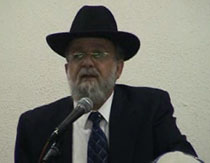Beit Midrash
- Sections
- Chemdat Yamim
- Parashat Hashavua
- Torah Portion and Tanach
- Shmot
- Vayakhel
We can easily identify a common order to the themes of the sections – command to build the Mishkan; Shabbat; the episode of the Golden Calf; Shabbat; building of the Mishkan. What is the significance of this order?
Rashi posits that the Torah is not bound to a chronological order. The episode of the Golden Calf occurred before the command to build the Mishkan, as the former was on Tamuz 17. The latter was after Yom Kippur, when Hashem forgave Bnei Yisrael, and was followed by contributing towards the Mishkan and finally its inauguration on Nisan 1.
The Ramban, on the other hand, argued that the command regarding the Mishkan preceded the breaking of the tablets, although it was repeated after the process of atonement was completed. According to the Ramban, the order of events described in the parshiyot was chronologically accurate. According to Rashi, why did the Torah write the command to build the Mishkan before the sin of the Golden Calf if it occurred after it? Both according to Rashi and the Ramban, one needs to explain why Shabbat is juxtaposed to the Golden Calf and the Mishkan. In order to explain this, let us look at Rashi’s comments regarding the two parshiyot discussing Shabbat.
Rashi in our parasha explains that Moshe writing about Shabbat before the Mishkan teaches us that the construction of the Mishkan does not override Shabbat. However, in Parshat Ki Tisa, the command of Shabbat follows that of the Mishkan. It seems, then, that there is a contradiction on whether the order is an indication of which supersedes the other. Furthermore, the reason that Rashi gives in Ki Tisa for Shabbat being kept even in the face of constructing the Mishkan is that the word "ach" excludes work done on Shabbat. However, since it is written within Shabbat, it should actually exclude the opposite – that work should be allowed on Shabbat for the sake of the Mishkan!
To answer these questions, let us recall the Vilna Gaon’s thesis. He explained that the command to build the Mishkan before the sin of the Golden Calf was never fully realized. The description of the actual building of the Mishkan that we find after the Golden Calf is not related to the previous commandment, as the order was changed after the sin. After the sin, the nation’s spiritual diminishment weakened the power of the Mishkan.
Before the Golden Calf, the command of Shabbat comes after the command to build the Mishkan. This teaches that in an ideal spiritual state, it would have been permitted to work even on Shabbat in order to build the Mishkan. After the sin, we live in a world where Shabbat must come first, and it was indeed forbidden to build on Shabbat even for the Mishkan.
Let us pray that we become worthy to rectify both things – to return to our spiritual heights before the sin of the Golden Calf and be worthy of building the Beit Hamikdash on the highest level.

The Brave of Strength Who Do His Will
Rabbi Yossef Carmel | 5768

Parashat Hashavua: Divinely Ordained Sibling Deceit
Rabbi Yossef Carmel | Cheshvan 5786

Parashat Hashavua: The Symbolism of Mashiv Haruach U’morid Hageshem
Rabbi Yossef Carmel | Tishrei 5786





















